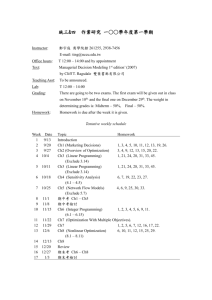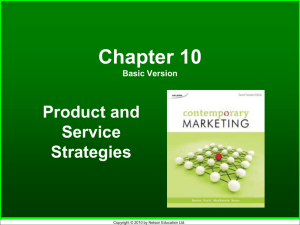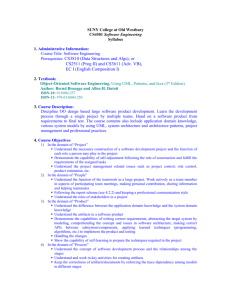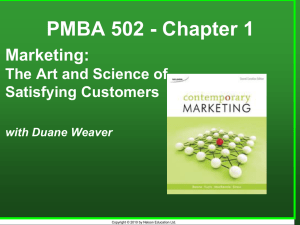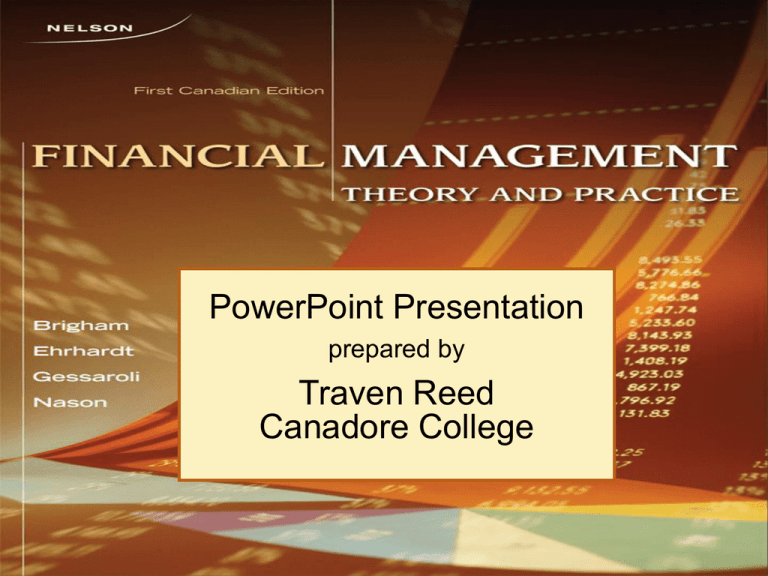
PowerPoint Presentation
prepared by
Traven Reed
Canadore College
chapter 8
Stocks, Stock Valuation,
and Stock Equilibrium
Corporate Valuation and
Stock Risk
CH8
Copyright © 2011 by Nelson Education Ltd. All rights reserved.
8-3
Topics in Chapter
CH8
•
•
•
•
Features of common stock
Determining common stock values
Efficient markets
Preferred stock
Copyright © 2011 by Nelson Education Ltd. All rights reserved.
8-4
Common Stock: Owners,
Directors, and Managers
CH8
•
•
•
•
•
Represents ownership.
Ownership implies control.
Stockholders elect directors.
Directors hire management.
Managers are “agents” of
shareholders, they always solicit
shareholders’ proxies and usually
succeed.
Copyright © 2011 by Nelson Education Ltd. All rights reserved.
8-5
Control of the Firm
CH8
• Shareholders often have the right (i.e.
preemptive right) to purchase any
additional shares sold by the firm
• This preemptive right protects the control
of the present shareholders and also
prevents dilution of their value
• The preemptive right makes it more
difficult to raise equity capital from new
large shareholders
Copyright © 2011 by Nelson Education Ltd. All rights reserved.
8-6
Types of Common Stock
CH8
• Not all common shares are created
equally
• Most firms have only one type of
common stock
• A system of dual-class shares is
used to meet the special needs of
the company
Copyright © 2011 by Nelson Education Ltd. All rights reserved.
8-7
Classified Stock
CH8
• Classified stock has special
provisions.
• Could classify existing stock as
founders’ shares, with voting rights
but dividend restrictions.
• New shares might be called “Class
A” shares, with voting restrictions
but full dividend rights.
Copyright © 2011 by Nelson Education Ltd. All rights reserved.
8-8
Stock Market Reporting
CH8
• In the past, tracking stock is through the
business section of a daily newspaper.
• Today, we can get quotes all during the day
from a wide variety of Internet sources (e.g.
Globeinvestor.com).
• Comparing with once a day from the
newspaper prints, the 20-minute delay with
the Internet information is nothing.
• The quote provides the price a buyer would
have to pay (“Ask”) and the price someone
can sell the stock (“Bid”) for.
Copyright © 2011 by Nelson Education Ltd. All rights reserved.
8-9
Different Approaches for
Valuing Common Stock
CH8
• Most stock’s expected total return =
dividend yield + capital gains yield
• Intrinsic value of a stock is the
present value of its expected future
cash flow stream
– Dividend growth model
– Free cash flow approach
– Using the multiples of comparable firms
Copyright © 2011 by Nelson Education Ltd. All rights reserved.
8-10
Stock Value = PV of
expected future dividends
CH8
^
P0 =
D1
(1+rs)1
+
D2
(1+rs)2
+
D3
+…+
(1+rs)3
D∞
(1+rs)∞
What is a constant growth stock?
One whose dividends are expected
to grow forever at a constant rate, g.
Copyright © 2011 by Nelson Education Ltd. All rights reserved.
8-11
For a constant growth stock:
CH8
D1 = D0(1+g)1
D2 = D0(1+g)2
Dt = D0(1+g)t
If g is constant and less than rs, then:
^
D0(1+g)
P0 =
rs - g
D1
=
rs - g
Use decimals, not % in the calculation
Copyright © 2011 by Nelson Education Ltd. All rights reserved.
8-12
CH8
Dividend and Earnings
Growth
• Growth in dividends occurs primarily as
a result of growth in EPS.
• Earnings growth results from a number
of factors: (1) inflation, (2) reinvested
profit, and (3) ROE.
• Firms cannot increase stock price by just
raising the current dividend.
• There is a tradeoff between current
dividends and future dividends.
Copyright © 2011 by Nelson Education Ltd. All rights reserved.
8-13
Intrinsic Stock Value vs.
Quarterly Earnings
CH8
• If most of a stock’s value is due to longterm cash flows, why do so many
managers focus on quarterly earnings?
• Sometimes changes in quarterly
earnings are a signal of future changes
in cash flows. This would affect the
current stock price.
• Sometimes managers have bonuses tied
to quarterly earnings.
Copyright © 2011 by Nelson Education Ltd. All rights reserved.
8-14
Dividend Growth and PV of
Dividends: P0 = ∑(PVof Dt)
CH8
$
0.25
Dt = D0(1 + g)t
Dt
PV of Dt =
(1 + rS)t
If g > rs , P0 = ∞ !
Years (t)
Copyright © 2011 by Nelson Education Ltd. All rights reserved.
8-15
What happens if g > rs?
CH8
^
P0 =
D0(1+g)1
(1+rs)1
If g > rs, then
+
D0(1+g)2
+…+
D0(1+rs)∞
(1+rs)∞
(1+rs)2
(1+g)t
> 1, and
^
P0 = ∞
(1+rs)t
So g must be less than rs to use the
constant growth model.
Copyright © 2011 by Nelson Education Ltd. All rights reserved.
8-16
Projected Dividends
CH8
• D0 = $2 and constant g = 6% = 0.06
• D1 = D0(1+g) = 2(1.06) = $2.12
• D2 = D1(1+g) = 2.12(1.06) =
$2.2472
• D3 = D2(1+g) = 2.2472(1.06) =
$2.3820
Copyright © 2011 by Nelson Education Ltd. All rights reserved.
8-17
CH8
Expected Dividends and PVs
(rs = 13%, D0 = $2, g = 6%)
0
1
g=6%
2.12
1.8761
1.7599
1.6508
2
2.2472
3
4
2.3820
13 %
Copyright © 2011 by Nelson Education Ltd. All rights reserved.
8-18
CH8
Intrinsic Stock Value:
D0 = $2.00, rs = 13%, g = 6%
Constant growth model:
^
D0(1+g)
P0 =
rs - g
D1
=
rs - g
$2.12
$2.12
=
=
$30.29
0.13 - 0.06
0.07
Copyright © 2011 by Nelson Education Ltd. All rights reserved.
8-19
Expected value one year
from now:
CH8
• D1 will have been paid, so expected
dividends are D2, D3, D4 and so on.
D2
^
$2.2427
P1 =
=
rs - g
0.07
= $32.10 = $30.29(1+0.06)
Copyright © 2011 by Nelson Education Ltd. All rights reserved.
8-20
Expected Dividend Yield and
Capital Gains Yield (Year 1)
CH8
D1
$2.12
Dividend yield =
=
= 7.0%
P0
$30.29
^
P1 - P0
$32.10 - $30.29
CG Yield =
=
P0
$30.29
= 6.0%
Copyright © 2011 by Nelson Education Ltd. All rights reserved.
8-21
Total Year-1 Return
CH8
• Total return = Dividend yield +
Capital gains yield.
• Total return = 7% + 6% = 13%
• Total return = 13% = rs
• For constant growth stock:
–
Capital gains yield = 6% = g
Copyright © 2011 by Nelson Education Ltd. All rights reserved.
8-22
CH8
Expected Rate of Return on
a Constant Growth Stock
D1
^
P0 =
to
rs - g
^
D1
rs =
P0
+g
^
Then, rs = $2.12/$30.29 + 0.06
= 0.07 + 0.06 = 13%
Copyright © 2011 by Nelson Education Ltd. All rights reserved.
8-23
If g = 0, the dividend stream
is a perpetuity
CH8
0 r =13%
s
1
2
3
2.00
2.00
2.00
PMT $2.00
P0 =
=
= $15.38
r
0.13
^
Copyright © 2011 by Nelson Education Ltd. All rights reserved.
8-24
Supernormal (Non-constant)
Growth Stock
CH8
• Supernormal growth of 30% for 3
years, and then long-run constant g
= 6%.
• Can no longer use constant growth
model.
• However, growth becomes constant
after 3 years.
Copyright © 2011 by Nelson Education Ltd. All rights reserved.
8-25
CH8
Nonconstant growth followed
by constant growth (D0 = $2):
0
1
rs=13%
g = 30%
2
g = 30%
2.60
3
g = 30%
3.38
4
g = 6%
4.394
4.6576
2.3009
2.6470
3.0453
46.1135
54.1067
= ^P0
$4.6576
^
P3 =
= $66.5371
0.13 – 0.06
Copyright © 2011 by Nelson Education Ltd. All rights reserved.
8-26
Dividend Growth Rates
CH8
Copyright © 2011 by Nelson Education Ltd. All rights reserved.
8-27
Suppose g = 0 for t = 1 to 3, and
then g is a constant 6%
CH8
0
rs=13%
g = 0%
1
2
g = 0%
2.00
1.7699
1.5663
1.3861
20.9895
25.7118
3
g = 0%
2.00
4
g = 6%
2.00
2.12
P 2.12 30.2857
3
0.07
Copyright © 2011 by Nelson Education Ltd. All rights reserved.
8-28
If g = -6%, would anyone buy
the stock? If so, at what price?
CH8
Firm still has earnings and still pays
^
dividends, so P0 > 0:
D0(1+g)
D1
^
P0 =
=
rs - g
rs - g
$2.00(0.94) $1.88
=
=
= $9.89
0.13 - (-0.06) 0.19
Copyright © 2011 by Nelson Education Ltd. All rights reserved.
8-29
CH8
Stock Valuation:
FCF Approach
• Firm value is the present value of
its future expected free cash flows
(FCF) discounted at the WACC.
• Since PV (FCF) is the present value
of a growing annuity, we have
FCF (1 g )
V
WACC g
Copyright © 2011 by Nelson Education Ltd. All rights reserved.
8-30
Using Stock Price Multiples
to Estimate Stock Price
CH8
• Analysts often use the P/E multiple
(the price per share divided by the
earnings per share).
• Example:
– Estimate the average P/E ratio of
comparable firms. This is the P/E
multiple.
– Multiply this average P/E ratio by the
expected earnings of the company to
estimate its stock price.
Copyright © 2011 by Nelson Education Ltd. All rights reserved.
8-31
Using Entity Multiples
CH8
• The entity value (V) is:
– the market value of equity (# shares of stock
multiplied by the price per share)
– plus the value of debt.
• Pick a measure, such as EBITDA, Sales,
Customers, Eyeballs, etc.
• Calculate the average entity ratio for a
sample of comparable firms. For
example,
– V/EBITDA
– V/Customers
Copyright © 2011 by Nelson Education Ltd. All rights reserved.
8-32
Using Entity Multiples (cont’d)
CH8
• Find the entity value of the firm in
question. For example,
– Multiply the firm’s sales by the V/Sales
multiple.
– Multiply the firm’s # of customers by the
V/Customers ratio
• The result is the total value of the firm.
• Subtract the firm’s debt to get the total
value of equity.
• Divide by the number of shares to get
the price per share.
Copyright © 2011 by Nelson Education Ltd. All rights reserved.
8-33
Problems with Market
Multiple Methods
CH8
• It is often hard to find comparable firms.
• The average ratio for the sample of
comparable firms often has a wide
range.
– For example, the average P/E ratio might be
20, but the range could be from 10 to 50.
How do you know whether your firm should
be compared to the low, average, or high
performers?
Copyright © 2011 by Nelson Education Ltd. All rights reserved.
8-34
Preferred Stock
CH8
• Hybrid security.
• Similar to bonds in that preferred
stockholders receive a fixed dividend
which must be paid before dividends
can be paid on common stock.
• However, unlike bonds, preferred
stock dividends can be omitted
without fear of pushing the firm into
bankruptcy.
Copyright © 2011 by Nelson Education Ltd. All rights reserved.
8-35
Preferred Stock Valuation
CH8
• Similar to the valuation of perpetual
bonds
DPS
VPS
rPS
• A preferred stock pays a quarterly
dividend of $1.25 ($5 per year) with
a required return of10%. Its value
DPS 4($1.25) $5
is
VPS
rPS
0.1
0.1
Copyright © 2011 by Nelson Education Ltd. All rights reserved.
$50
8-36
Expected return: given Vps = $50
and annual dividend = $5
CH8
$5
Vps = $50 =
$5
^
rps =
$50
^
rps
= 0.10 = 10.0%
Copyright © 2011 by Nelson Education Ltd. All rights reserved.
8-37
CH8
Stock Price Volatility for
changes in rS and g
• Are volatile stock prices consistent with
rationing pricing?
• Small changes in expected g and rs
cause large changes in stock prices.
• As new information arrives, investors
continually update their estimates of g
and rs.
• If stock prices are not volatile, then this
means there is not a good flow of
information.
Copyright © 2011 by Nelson Education Ltd. All rights reserved.
8-38
Stock Market Equilibrium
CH8
• In equilibrium, stock prices are
stable. There is no general
tendency for people to buy versus
to sell.
• The expected price, P, must equal
the actual price, P. In other words,
the fundamental value must be the
same as the price.
Copyright © 2011 by Nelson Education Ltd. All rights reserved.
8-39
In equilibrium, expected returns
must equal required returns:
CH8
^
rs = D1/P0 + g = rs = rRF + (rM - rRF)b
Copyright © 2011 by Nelson Education Ltd. All rights reserved.
8-40
How is equilibrium
established?
CH8
^
D
If rs = 1 + g > rs, then P0 is “too low.”
P0
^
If the price is lower than the fundamental
value, then the stock is a “bargain.” Buy
orders will exceed sell orders, the price
will be bid up until:
^
D1/P0 + g = rs = rs
Copyright © 2011 by Nelson Education Ltd. All rights reserved.
8-41
Efficient Market Hypothesis
CH8
• Securities are normally in equilibrium
and are “fairly priced.”
• Investors cannot “beat the market”
except through good luck or inside
information.
• The prices of securities fully reflect
available information. They will adjust
immediately to any new development.
Copyright © 2011 by Nelson Education Ltd. All rights reserved.
8-42
Weak-form EMH
CH8
• Investors buying bonds and stocks
cannot profit by looking at past
trends. A recent decline is no
reason to think stocks will go up (or
down) in the future. Evidence
supports weak-form EMH, but
“technical analysis” is still used.
Copyright © 2011 by Nelson Education Ltd. All rights reserved.
8-43
Semistrong-form EMH
CH8
• All publicly available information is
reflected in stock prices, so it does
not pay to pore over annual reports
looking for undervalued stocks.
Largely true.
Copyright © 2011 by Nelson Education Ltd. All rights reserved.
8-44
Strong-form EMH
CH8
• All information, even inside
information, is embedded in stock
prices. Not true--insiders can gain
by trading on the basis of insider
information, but that is illegal!
Copyright © 2011 by Nelson Education Ltd. All rights reserved.
8-45
Markets are generally
efficient because:
CH8
• 100,000 or so trained analysts-MBAs, CFAs, and PhDs--work for
firms like Fidelity, Merrill, Morgan,
and Prudential.
• These analysts have similar access
to data and megabucks to invest.
• Thus, news is reflected in P0 almost
instantaneously.
Copyright © 2011 by Nelson Education Ltd. All rights reserved.
8-46

